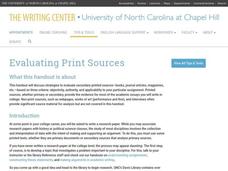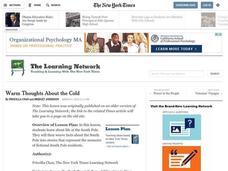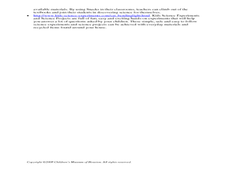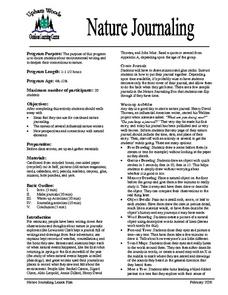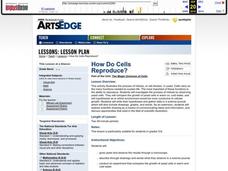University of North Carolina
Evaluating Print Sources
Not all sources are created equal, so how do you evaluate them? Writers learn how to evaluate print sources based on elements such as audience, tone, and argument in the sixth handout of 24 in the Writing the Paper series from the...
Curated OER
Up For Renewal
Want to know more about China's energy resources? Scholars will explore renewable resources implemented in China's energy plan. The will discover various types of renewable energy sources and discover how China is taping into these types...
Curated OER
Warm Thoughts About the Cold
“What do you think life is like at the South Pole?” After responding to this journal prompt, class members read and discuss the New York Times article, “At South Pole, New Home for a New Era.” Using resources available from the Times’...
Virginia Department of Education
Historical Models of Atoms
What does the past have to do with today? Young scientists find that answer as they learn more about past chemists and their significant contributions to the field. Pupils use the Internet to research historical figures and create a...
Curated OER
Light Travels Through Objects
Students experiment with materials that allow light to pass through. In this physical science lesson, students investigate the way light is absorbed by many different glass objects and household items. Students write their descriptive...
Curated OER
Nature Journaling
Writers participate in a unique form of environmental writing and deepen their connections to nature through journaling. They generate new ideas and thoughts that they can use for continued nature journaling and explore a variety of...
California Academy of Science
What Would Happen?
Nothing says classroom fun like an invertebrate and a magnifying glass! Snails, earthworms, and roly-poly bugs become the center of attention as pint-sized investigators hone their inquiry and observation skills. They are guided through...
Curated OER
How Do Cells Reproduce?
Beginning biologists prepare a sugar solution for yeast cells to live in, and divide it into two different jars. Samples from each jar are viewed with a microscope, and then one jar is placed in a warm environment and the other a cold...
Curated OER
Illinois Biodiversity
Students examine the amount of biodiversity in the state of Illinois. They practice using new vocabulary and listening to stories about animals. After given time to reflect, they write their own haiku. They work together to create a...
Curated OER
Habitats
Students examine how different living things interact with their environment. As a class, they discuss the characteristics of a habitat and write the list on the board. In groups, they focus on one habitat and create a mural of the...
Curated OER
Understanding Science Fiction
Fourth graders learn about the genre of science fiction. In this science fiction lesson, 4th graders learn about the characteristics of science fiction as a genre. They write an original piece of science fiction.
Kids Discover
Galaxies by KIDS DISCOVER
An e-magazine with kid-friendly informational text, vibrant visuals, and activities about galaxies.
Curated OER
Water Properties introduction
Students list items they know and want to know about water on personal K-W-L charts. They describe what happened during the warm up activity in their science journal. Students travel to four different stations and perform the different...
Curated OER
The Sun: An Introduction
Students write entries in their Science Journals as they explore the Sun.
Curated OER
Let's Start Growing
Students investigate how a tree grows from a seed. In this plant biology lesson, students use potting soil, tree seeds, and a paper cup to observe seeds growing into plants. Students record observations in their science journals.
Curated OER
How Does Your Garden Grow?
Students discover gardening by documenting plants grown on school grounds. In this botany lesson, students utilize digital cameras to capture images of plants on photo hikes which are turned into a slide show. Students plant a garden...
Curated OER
Renewable vs. Non-Renewable Resources
Fifth graders, after brainstorming why conservation of resources is important, distinguish between renewable and non-renewable resources. They make a list of different types of natural resources on the board and then sort them into two...
Curated OER
Writing an Essay- The Circulatory System
Fifth graders write an essay. In this writing lesson, 5th graders research the circulatory system and organize their notes into an outline. Students write an informational essay on the circulatory system.
Curated OER
Food Journal Exercise
Students are required not to change their usual eating pattern while recording everything they eat and drink for 1 day. They evaluate the nutrient composition of their diet, as well as their dietary intake and behavior within the...
Curated OER
Sequence Writing: Life Cycles - Plant Life
Students investigate the stages of plant life. Students create a K-W-L chart. They describe six main stages of the plant life cycles. Using stickers, students create a life cycle flow map.
Curated OER
Girls Around the World: Communicating Through First-Person Narratives
Teams select a society to investigate and create a chart comparing and contrasting the status of girls in that society with their own. They then craft and illustrate a personal narrative written from the point of view of a girl living in...
Curated OER
An Introduction to Nutrition
Whether you need a new textbook for your health class, or a few exercises and passages for your lesson on nutrition, you'll find what you need with a thorough nutritional science resource. With 15 chapters that cover elements of...
Penguin Books
A Teacher’s Guide to the Signet Classics Edition of Mary Shelley ’s Frankenstein
Contrary to popular belief, the monster's name in Mary Shelley's Frankenstein is not Frankenstein. A teacher's guide for the novel helps readers make sense of key details in the text, define vocabulary words, and discuss prominent...
Virginia Department of Education
Logic and Conditional Statements
If there is a conditional statement, then there is a hypothesis and conclusion. Pupils learn how to identify the parts of conditional statements. Class members continue to work with conditional statements and rewrite them in their many...


